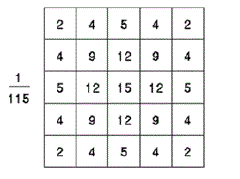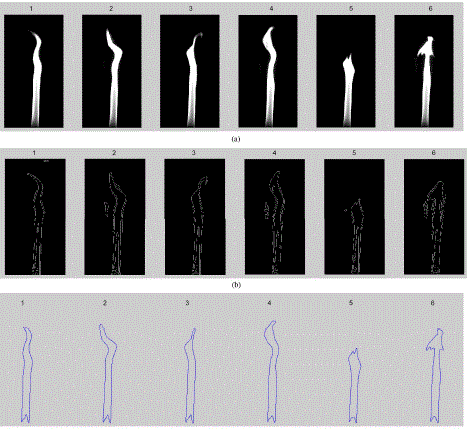Keywords
|
| Edge detection, image processing, Feature extraction, flame/fire image edge analysis. |
INTRODUCTION
|
| Fire is a serious phenomenon that is out of control in space and time due to that it will cause serious loss of life and property once it happened. To study the combustion efficiency and pollutant emission quantitative flame monitoring is important in fossil fuel fired combustion system, particularly in power generation plants[1].There are many conventional flame detector systems that are based on optical sensing, ionization current detection and thermocouple[2]. |
| Image based system can detect uncontrolled fire at an early stage before they turn into disaster. The advantages of fire detection technology based on video image are, detection techniques are intuitive, image can save more scene information through colour and texture which is helpful for the detection method greatly. |
| Edge detection is an important step in flame and fire image processing. It is necessary to identify the flame edges for several reasons. The flame edges are basis for the quantitative determination of range of flame characteristic parameter such as shape, size, location and stability. The flame edges can reduce the amount of data processing and filter out uncontrolled information such as background noise within image. This timely determination of flame edges can trigger a fire alarm and provide the fire fighter with information on fire type, combustible substances, exterior of the flame. This is useful for the identification of false and real fire alarms [3]. |
| There are numerous methods are present for edge detection. Adkins developed a manual edge detection method. It is a software tool to analyze the fire images, but it does show the importance and usefulness of the flame/fire edge detection. The Zhang et al. [4] presented a new method using FFT and wavelet transform for counter analysis of forest fire images on a video. Toreyin et al. [5], [6], [7] proposes edge detection in real time video using different methods such as hidden Markov models and wavelet transform. Jiang and Wang [8] demonstrated an improved Canny edge detector which was used to detect moving fire regions in large space fire images. These methods have some limitations. For instance, some flame edges detected are unclear, discontinuous or do not well match the actual flame shape. For the purpose of detecting the flame’s shape and size, it is necessary to attain the clear, continuous and where possible, closed edge of the flame. |
EXISTING SYSTEM
|
| A typical edge in an image might, for instance, be the border between blocks of different colors or different gray levels. Mathematically, the edges are represented by first -and second-order derivatives. The edge detection methods that have been published may be grouped into two categories according to the computation of image gradients, i.e., the first order or second order derivatives. Examples are Roberts, Prewitt, and Sobel operators [9]. The Canny edge-detection algorithm [10], an improved method using the Sobel operator, is known as to be the powerful edge detection method. In the second category, edges are detected by searching a second order derivative expression over the image, usually the zero crossing s of the Laplacian or a nonlinear differential expression. |
| Even though, these common edge detection methods have been applied with appropriate parameters, flame edges are not clearly identified. The edges defined using these methods are often disconnected and fragmented. It is therefore desirable to develop a dedicated edge-detection method for flame/fire image processing. |
PROPOSED ALGORITHM
|
| A flame region has a stronger luminance in comparison to its ambient background and the boundary between the flame region and its background is mostly continuous. The strategy used is to detect the coarse and the superfluous edges in a flame image, if there is only one main flame and if the image contains multiple flames, it is segmented as to contain one flame. Identify the flame’s primary edge and remove irrelevant ones to project the continuous edge. |
| The algorithm has been split into following logical steps: |
| Step 1 – Adjusting the grey level of a flame image. |
| As the image has a wide distributed scale of the grey levels, an initial adjustment is required to redistribute using a histogram to equalize the grey levels to be spread entirely over the given image normalized in the range [0,1]. Using the probability of the occurrence of a pixel of gray level i in the image is [11] |
 |
| L – Total number of grey levels in the image. |
| n – Total number of pixels in the image. |
| ni – Total number of pixels with grey level i. |
| The Cumulative distribution function CDF is used for redistribution and equalization given by |
 |
| Step 2 – Smoothening the image to eliminate noise. |
| The image considered with variation in the grayscale represented as noise is filtered using the standardconvolution methods by application of a suitable mask. A Gaussian mask is selected to minimize thelocalization edges to preserve the edges for further detection. |
 |
| Step 3 – Using the Sobel operator for finding the basic edges |
| The Sobel operator is applied to the image to detect the preliminary edges by performing a spatialgradient over the image that reveals the distinct pixels by their gray scale varied from its neighboring pixels. The strength & the direction of the edges pixels are retrieved from this gradient & magnitude respectively. The Sobel operators applied horizontally and vertically to find the gradient in the x and y direction respectively are |
 |
| Step 4 – Adjusting Thresholds for better results. |
| The two thresholds are used to classify the pixel to belong to the edge if the magnitude of the gradient is higher than TH or if there is a path to another pixel which is above TL. All the other pixels not at the peak of the gradient are suppressed to highlight the edge. A preliminary edge image (PEI) is formed by detecting all the pixels foreseen to belong to the edge represented with discontinuous contour. These are further eliminated by interpolation through which the gaps between the contours existing as part of the background pixels are highlighted and connected using the 4 neighborhoods. |
| Step 5 – Removing unrelated edges in the PEI. |
| The PEI acquired from the previous image is traced by forming blocks of matrices with varying sizes to eliminate those pixels that are not a part of the edge revealed. For every pixel belonging to the edge, it isverified to have either one or more neighboring points or a conjunction of points based on which it is deduced to be either an isolated point or an end point or a normal transition point. All those points that have not beendeducted are eliminated from the PEI. |
| Step 6 – Achieving a clearly defined edge. |
The Euclidean distance measure D is computed for the starting and ending point of the contour defined from the previous process to evaluate the curve representing the edge of the flame is closed else LMS computation process is applied to derive an adjusted TH. The Euclidean Distance D is computed between the Cs(Sx, Sy) and Ce (Ex, Ey)  |
SIMULATION RESULTS
|
| Many flame videos are also tested for continuous edge detectionso as to evaluate the robustness of the system. It is clear that the flame edges detected using the Canny edge-detection method are unclear and discontinuous, while the results obtained using the proposed algorithm show clear and continuous edges with parameters automatically adapted. With a clearly defined flame/fire edge, various flame/fire parameters can be easily computed for the shape description. For instance, the flame area can be counted by the number of pixels inside the flame edge; the chain coding of a flame edge can be used to describe a 2-D flame/fire shape; the perimeter of a flame can be achieved by the total number of pixels of the detected flame edge boundary.It would be difficult to obtain this result without the clear edge detection. Using the proposed edge-detection algorithm, further work can be done to characterize the geometric features of flames/fires and, consequently, establish their relationship with combustion conditions such as air/fuel inputs and emissions. |
Figures at a glance
|
 |
| Figure 1 |
|
| |
References
|
- D. Roddy, Advanced Power Plant Materials, Design and Technology. Cambridge, U.K.: Woodhead Publ., 2010.
- S. M. Razmi, N. Saad, and V. S. Asirvadam, “Vision-based flame analysis using motion and edge detection,” in Proc. ICIAS, no. Jun. 15–17,2010, pp. 1–4.
- B. U. Toreyin and A. E. Cetin, “Online detection of fire in video,” in Proc. IEEE Conf. CVPR, pp 1-5,2007.
- Z. Zhang, J. Zhao, D. Zhang, C. Qu, Y. Ke, and B. Cai, “Contour based forest fire detection using FFT and wavelet,” in Proc. Int. Conf. CSSE,Wuhan, China,pp 760-763, Dec. 12–14, 2008, .
- B. U. Toreyin, Y. Dedeoglu, and A. E. Cetin, “Flame detection in video using hidden Markov models,” in Proc. IEEE ICIP, p. II-1230-3,sep11-14 2005.
- B. U. Toreyin, Y. Dedeoglu, U. Gudukbay, and A. E. Cetin, “Computer vision based method for real-time fire and flame detection,”PatternRecognit. Lett., vol. 27, no. 1, pp. 49–58, Jan. 1, 2006.
- B. U. Toreyin and A. E. Cetin, “Online detection of fire in video,” in Proc IEEE Conf. CVPR, 2007, pp. 1–5.
- Q. Jiang and Q. Wang, “Large space fire image processing of improving canny edge detector based on adaptive smoothing,” in Proc. Int.CICCITOE, pp. 264–267,2010.
- D. Ziou and S. Tabbone, “Edge detection techniques: An overview,” Int. J. Pattern Recognit. Image Anal., vol. 8, no.4,pp. 537–559, 1998.
- J. Canny, “A computational approach to edge detection,” IEEE Trans.Pattern Anal. Mach. Intell., vol. PAMI-8, no. 6, pp. 679–698, Nov. 1986.
- K. R. Castleman, Digital Image Processing. Englewood Cliffs, NJ:Prentice-Hall, 1995.
|